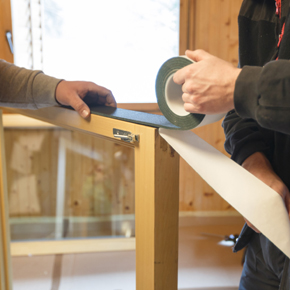
Are technical tapes replacing traditional mechanical fastening methods?
Adrian Askey of Castle Tapes Holdings discusses how technical tapes can provide construction industry professionals with a solid alternative to traditional fastening methods.
Technical tapes have been used throughout the construction industry for many years. However, technology moves at a fast pace, and so do innovations within the tapes and adhesive market.
The demand for improved product capabilities and product offering has increased with the need for quicker, more efficient, and cost effective working practices.
Technical tapes are suitable for a growing number of applications throughout the construction industry, including:
- The bonding of door panels;
- The mounting glass elements;
- Work on trims and profiles;
- Constructive window glazing and mounting window trims;
- Building design;
- Interiors.
Technical tapes achieve no nonsense, long term bonding no matter what the application.
An alternative to traditional fastening
High performance tapes can achieve a strong, permanent and reliable bond to a range of substrates: metals, woods, plastics and laminate and composite materials.
With traditional fastening methods, such as welding, screws, bolts, and rivets, there are often weak spots due to stresses not being distributed evenly. Tapes can help to eliminate this problem, with even distribution of any stresses across the full bond.
Using mechanical fixings often means measuring, drilling, and post-fit refinishing work; when using tapes, maintenance can be as simple as wiping surfaces with an appropriate surface preparation solution and applying tape to bring the materials together that are being bonded.
This being said, when traditional methods of fastening fail, failure is usually quick and sudden. The first sign of failure is often a clean break. This, in turn, adds to your amount of wasted resources and materials. In comparison, technical tapes can accommodate stress and movement, offering a better bond strength than traditional fixing methods.
When joining substrates together, visible marks and damage can be an issue with certain fastening methods. Tapes, however, can often be removed without surface damage. With other fastening methods, mistakes can be costly as they are often hard to put right.
When considering the above, as well as other contributing factors, technical tapes can offer improved efficiencies, productivity, and significant cost savings.
Latest news

21st February 2025
ASSA ABLOY EMEIA: Save valuable time and money with a seamless switch to programmable digital keys
In 2025, access management can be a whole lot easier. By making access part of their digital processes, businesses can put time-consuming key management and the cost of changing the locks firmly behind them. Making this switch is a lot easier than many people think, as ASSA ABLOY explains here…
Posted in Access Control & Door Entry Systems, Architectural Ironmongery, Articles, Building Industry News, Building Products & Structures, Building Services, Doors, Facility Management & Building Services, Health & Safety, Information Technology, Innovations & New Products, Retrofit & Renovation, Security and Fire Protection
21st February 2025
Showersave supports industry leaders in addressing Part L and Part G regulations
Showersave has sponsored and participated in a recent Building Insights LIVE roundtable on ‘Water & Energy Saving Innovations in New Build Housing’.
Posted in Articles, Bathrooms & Toilets, Bathrooms, Bedrooms & Washrooms, Building Associations & Institutes, Building Industry Events, Building Industry News, Building Products & Structures, Building Regulations & Accreditations, Building Services, Exhibitions and Conferences, Interiors, Pipes & Fittings, Plumbing, Retrofit & Renovation, Sustainability & Energy Efficiency
21st February 2025
GEZE: The importance of Specifying High Quality Door Closers on Fire Doors
Andy Howland, Sales & Marketing Director at GEZE UK, discusses why specifying high quality door closers on fire doors is important…
Posted in Access Control & Door Entry Systems, Accessibility, Architectural Ironmongery, Articles, Building Industry News, Building Products & Structures, Building Regulations & Accreditations, Building Services, Doors, Facility Management & Building Services, Health & Safety, Posts, Restoration & Refurbishment, Retrofit & Renovation, Security and Fire Protection
21st February 2025
Insight Data achieves ISO9001 recertification with zero non-conformities
Leading industry data specialist, Insight Data, has successfully achieved the prestigious recertification for ISO9001 with zero non-conformities for the fourth consecutive year.
Posted in Articles, Building Industry News, Building Regulations & Accreditations, Building Services, Information Technology, Research & Materials Testing
 Sign up:
Sign up: